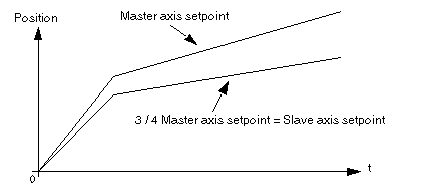This function is used to slave the position of an axis (called the slave axis) to the position of another axis from the same module (called the master axis).
The master axis is always the axis 0. A 2 axis module can have one master axis and one slave axis. A 4 axis module can have one master axis and up to 3 slave axes.
The position slave function is confirmed in the configuration screen. At programming level, the slave axis is slaved to the master axis when the SLAVE bit (%Qr.m.c.17) of this axis is set to 1. The IN_SLAVE bit (%Ir.m.c.36) indicates that the slave axis is operating in tracking mode.
An axis is slaved either to the measured position or to the master axis position setpoint (choice defined in configuration). A RATIO1 / RATIO2 ratio is applied in order to obtain the final setpoint. These 2 parameters are defined during configuration.
In order to indicate that the slave axis is tracking the master axis correctly, the AT_PNT (%Ir.m.c.9) bit of the slave axis is at 1 when the tracking error of the latter is lower than DMAX2.
For example, Ratio = 3/4, with slaving to the master axis setpoint.
-
The master axis is configured.
-
The slave axis is referenced.
-
No blocking fault is detected.
-
The slave axis is in automatic mode.
-
The master axis is in automatic or manual mode.
If the calculated setpoint overshoots the axis soft stops, the moving part stops and the command is refused.
-
For the calculated slave axis position setpoint to be valid, you must make sure that the slave axis is already at the Master x RATIO position before switching this axis to slave mode.
-
Reference point commands on the master axis must be avoided when there are slave axes (risk of tracking error fault on the slave axis).
-
In Tracking mode:
-
the TH_PNT, NEXT information bits are not managed,
-
the PAUSE command is not active,
-
CMV modifications are not taken into account (CMV = 1000).
